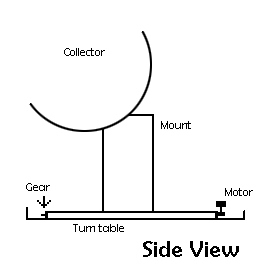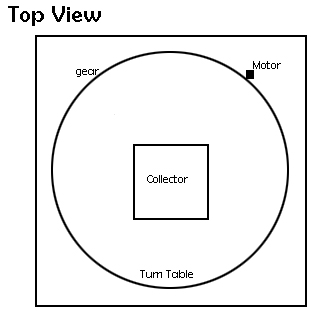 In what is fast becoming a popular column, Ask The Sietch is now on its third question.
In what is fast becoming a popular column, Ask The Sietch is now on its third question.
I recently got this from Noah
I have been researching solar thermal options and wish to create a solar thermal panel using a parabolic reflective surface, but I am not finding an easy way to create a solar tracking device, either one axis or two. Do the members of the Sietch have any ideas on solar tracking devices? Especially low cost.
Before we start Noah lets talk a little about maximizing your solar gain. Solar gain is the amount of sun your panel will be able to gather. You can maximize this by means of the angle and the position you mount your panel. You obviously know what I am talking about as your question is about a device to constantly maintain maximum solar gain, but for the benefit of everyone else lets talk a bit about finding the perfect angle.
What hemisphere you live in will determine which direction you should face your collector. If you live in the northern hemisphere face it south, if you live in the southern hemisphere face it south if you live in the middle face it up.
You also need to pick the proper angle to tilt your collector, this is dependent on what season you are in. Typically you place it more flat, parabola facing up in the summer, and more towards north or south (depending on your hemisphere) in the winter to capture more solar energy.
Face your collector solar south (if in the north) or solar north (if in the south) and use this table to help you figure out your tilt. A quick way to determine solar south/north is to divide the span of time between sunrise and sunset in half. The position of the sun at the resulting time would be true solar south/north.
Site Latitude— Recommended tilt angle
0° to 4° —— 10°
5° to 20° —— latitude + 5°
21° to 45°—— latitude + 10°
46° to 65°—— latitude + 15°
65° to 75°——- 80°
These values are sort of an average for summer and winter, they should provide “year round” maximum solar gain. Further tweaking will allow you to find the proper angle if you wish maximum seasonal gain.
The problem is that the sun moves throughout the day. So if you properly angle your collector for the morning sun by mid day it will not be getting much solar gain. Hence people have invented trackers, these devices move throughout the day to constantly point your collector at the sun.
The cheapest method of solar tracking would be to affix your parabolic collector at the proper angle, and then mount it on a movable base. Every couple of hours you would have to come out and move it. At the end of the day you would have to move it back into position for the next day. Obviously this method has some serious drawbacks. Who wants to be spending all day fiddling with their solar collectors.
To moderate this device you might be able to make the rotation of the device automated using a small motor. With creative gearing, or the use of a worm gear or belt system you may be able to slowly turn the device throughout the day. The idea would be to use a low power slow motor to ever so slowly rotate your fixed angle collector. The time it takes for your collector to make one full turn should be 24 hours. In this way the collector is once again pointing towards the east to capture the morning sun. This would greatly increase the solar gain you get from your collector.


You could also buy a commercial tracking unit. This saves time, but might not save you money.
Trackers come in a couple different flavors. There are one axis and two axis trackers.
Single axis trackers, track one path across the sky, they would have to be permanently affixed at a certain angle and track an arc across the sky, this arc is called the Eclipse and encompasses the path that the sun takes.
Two axis trackers do more. One axis is a vertical pivot shaft or horizontal ring mount, that allows the device to be swung to a compass point. The second axis is a horizontal elevation pivot mounted upon the azimuth platform. By using combinations of the two axis, any location in the upward hemisphere may be pointed. This would allow you to not only track the path of the sun, but also track the seasonal and daily shifts in the height in the sky (azimuth) of the sun. For instance in the winter the sun will be much lower on the horizon than in the summer, two axis trackers allow you to maximize the amount of sun you will gain year round.
Trackers also come in two types, passive and active. Passive trackers use heat sensitive gas or fluid to automatically shift from east to west throughout the day. Passive tracks are always one axis trackers.
Active trackers use computer controlled motors to move the collectors throughout the day. They can be one or two axis trackers.
Passive trackers have the benefit of low maintenance costs (few moving parts) but do not have the range of tracking movement. Active trackers allow greater movement but use electricity (might not be such a good idea if the tracker motor uses are large percentage of the energy produced by the collector) and have more moving parts making for more complicated maintenance problems.
So what are you to do?
Well many companies make solar trackers, they range from cheap and rugged passive trackers, to very expensive high tech low energy usage two axis active trackers. For a parabolic collector you would need a two axis tracker to maximise year round collection, but a one axis tracker mounted at the correct angle will also increase the amount of solar gain, just not as much.
Here are a couple companies that sell trackers. They range in price. Many of these companies make a solar PV tracker system, it might be a challenge to mount a parabolic collector system to some of them, but I feel it could be done using a creative hose setup. You might need to use some metal hose pivot joints to move your heat collecting fluid without causing hose kinks. Or you may be able to contact some of them to figure out if they build a parabolic tracker.
This small tracker could be used if your collector was small.
Here is a list of some commercially available tracker suppliers.
- Ecoware
- Powerlight
- wattsun
- zomeworks
- Lorentz
- Traxle
- Solazone
- Solon Movers
- Solenergy
- Dobon Tech
- InSpira
- DegerEnergie
I hope this helps. As always if you feel you have any information that would help Noah out feel free to leave a comment.
http://www.ecogeek.org/content/view/514/
This is a motorless solar tracker that may be of interest.
Hi,
How is build parabolic collector? How is calculated?
Which is angle? I want to do parabolic. So, how is it.
Tanks